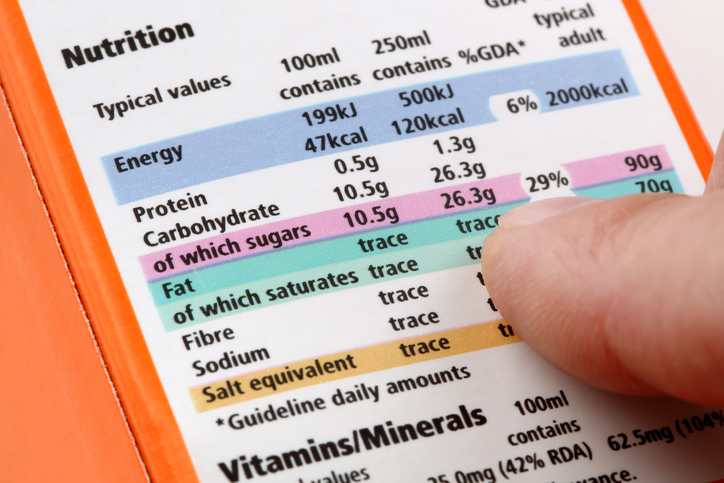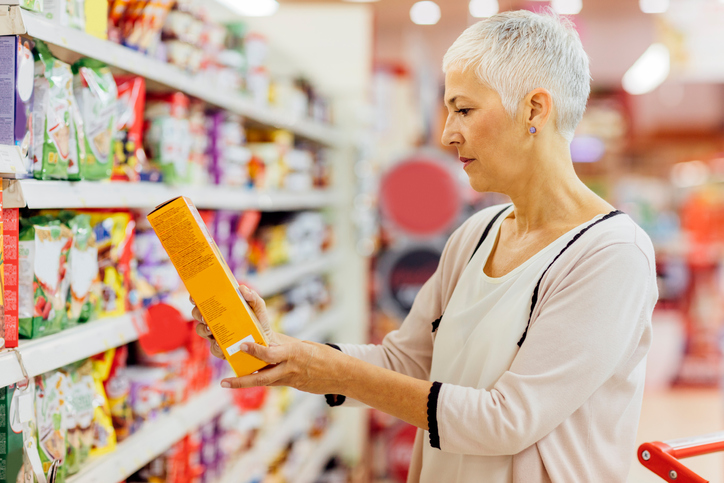Understanding a food label and decoding what is healthy and what is not from a list of numbers and ingredients can be a minefield, but does a ‘clean label’ actually help?

Recent years have seen an increasing consumer demand for food and drink products to be ‘clean label’, natural and only contain ‘storecupboard’ ingredients. The big challenge that this presents is that it is an unregulated set of ideals that ultimately can lead to a lack of clarity and understanding.
It is generally considered to be ‘using natural alternatives to food additives and that these ingredients are listed on labels as the named ingredients rather than by E-numbers so that they sound familiar to the consumer.’ This definition does not extend far enough since clean label is increasingly seen to include ingredients themselves. For example, not only is the amount of fat or sugar important, but the type, its origin and the processes applied to it are drawn into the clean label discussion. Typical examples here are Hydrogenated vegetable oils and High Fructose Corn Syrup (HFCS). However, some ingredients are excluded from the clean label tool kit even though they are natural, as they don’t sound natural.
There are various attempts to clarify the situation. In the US, the Food and Drug Administration (FDA) has indicated that the term ‘natural’ may be used provided it is truthful and not misleading (i.e. the product does not contain any artificial flavour or flavourings, colouring ingredients, chemical preservatives or any other artificial or synthetic ingredients) and the product and its ingredients are not more than minimally processed. The Food Standards Agency (FSA) also provides similar guidance for the use of the terms ‘fresh’, ‘pure’, ‘natural’ etc. in food labelling. However, these tend to deal with the use of ‘natural’ in labelling and not the full ‘clean label’ picture.
So, it’s generally accepted that ‘clean label’ is the removal of chemical-sounding ingredients, artificial additives and E numbers, and even extends to the creation of healthier labels with the removal or reduction of salt, fat and sugar. It reaches even further to consider ingredients with a ‘natural’ profile or that are minimally processed. This shift has also brought into usage the term ‘storecupboard’ ingredients which, in its most simple form, can be considered as ingredients that the consumer recognises, while also understanding their function in
the product.
It is actually straightforward then – remove the ‘baddies’ and replace with ‘goodies’; but while product developers are tentatively reaching for their sheriff’s badges and hat, they will be doing so with some trepidation. After all, although the sentiment of the ‘clean label’ agenda is ideal, the practicality of its implementation is somewhat different and this creates the ‘clean label’ paradox; consumers are setting the conditions for product profiles, but they don’t know what the rules are.
E numbers
Additives were assigned ‘E’ numbers as far back as 1964, with a unified list for colours being assigned a number via the International Numbering Scheme. This was done to show consumers that food safety was a priority and that additives were tested and approved. This also provided structure and categorisation that formed part of the EU Labelling Directive which dictate that food needs to be safe to eat and labelling must not be misleading.
They were quickly treated with suspicion and, in the media and consumers’ eyes, they became the hallmark of everything they were designed to combat. It was felt they were an opportunity for the food and drink industry to ‘hide’ the use of unnecessary components. The reaction to this was to use the ingredients’ name, which compounded the issue further; since functional additives such as Emulsifier: E471, or mono- and di-glycerides of fatty acids only fuelled the concern over unnecessary chemical use. This was for no reason other than it sounded like a chemical, regardless of specific function or its safety. This only fuels the clean label paradox further.

Which would you rather in your product?
The opportunity to fully educate everyone in E numbers and additives has probably long expired, so the platform to be successful in the ‘clean label’ space exists. Many personnel in the food industry may be frustrated by the treatment of E numbers, and scientists may even take comfort in the rigid and familiar characterisation of additives; they provide unambiguous and consistent nomenclature and they save space on labels. The ‘clean label’ trend has been on the rise for a number of years, and is set to remain, so these elements need to be put to one side. In order to move forward with a sense of understanding of consumer needs, it needs to be embraced as a philosophy.
Don’t put XYZ in my product
As we’ve indicated, clean label is driven by a consumer need to understand a food label by recognising the ingredients. This can however conflict with ‘naturalness’ since certain ingredients could be considered ‘natural’, but not clean label through lack of familiarity. A reasonable example of this is xanthan gum (E415) – it is considered by many to be ‘natural’ since it is derived from the fermentation of sugars such as sucrose, however it is not an ingredient typically found ‘in store cupboards’ and would not necessarily be recognised by a consumer, thus it might not be considered ‘clean label’. It has been found in consumer studies that xanthan gum is considered with scepticism, not from its fermented origin, but because of its name; it has an ‘x’ in it! And there is a wide misconception that ingredients that contain ‘X’, ‘Y’ or ‘Z’ must be chemical and can’t be natural. This of course is untrue.
There is a significant increase in ‘free-from’; products. And in the case of bread, xanthan gum is a common ingredient to help replace the functionality that gluten provides in structuring the bread. Does this mean that ‘free-from’ products fail the ‘clean label’ test and there should be cause for concern over the use of additives? The use of xanthan gum in this context is necessary to deliver the desired product, and xanthan gum should be considered suitably clean label even if its E number is used on the label.
Sugar and spice and all things nice
A similar debate has arisen around the need for sugar reduction in a range of products. However, sugar performs a range of functions within a product; delivering sweetness, flavour, texture, structure and preservative properties. Combinations of intense sweeteners and sugar alcohols (polyols) are common alternatives to sugar, since they have a reduced calorie profile. Since polyols are known to have laxative effects, advisory comments are required on-pack warning about the effects of excessive consumption. They are also less sweet than sucrose and often require additional sweetness enhancement and blends of sweeteners may be required to deliver the taste and sweetness profile. There is little dispute regarding excessive sugar consumption not being beneficial to long-term health, but the additional labelling requirements and replacement of a single ingredient with three less identifiable and chemical sounding alternatives may be detrimental to the healthy perception of the reformulated product.
Don’t get me wrong, making food products simpler and less processed is a great thing, but it doesn’t necessarily make them healthier and, with the confusion and inconsistency that arises from an unregulated trend, it doesn’t promise to get any clearer just yet.
The paradox in action
The need for a clear philosophy can be showcased through considering the use of E300.
- E300 – Approved food safe additive. Free-flowing white powder. Soluble, mild acid, antioxidant.
- Ascorbic Acid Chemical C6H8O6 – CAS # 50-81-7 Slightly hazardous in case of skin contact (irritant), of eye contact (irritant), of ingestion, of inhalation. Do not ingest. Do not breathe dust. If ingested, seek medical advice immediately and show the container or the label. May affect genetic material (mutagenic).
- Vitamin C – Any consumer knows that this is an ingredient that is good for them.
This simple example shows that one and the same ingredient can be viewed very differently, and as such demonstrates the complexity of ‘clean label’.
About the authors
 Steve Osborn and Naomi Diaz-Osborn are food industry experts and founding directors of The Aurora Ceres Partnership Ltd. Steve and Naomi have presented many conference papers and contributed articles in technical books and trade journals on special diets and clean label.
Steve Osborn and Naomi Diaz-Osborn are food industry experts and founding directors of The Aurora Ceres Partnership Ltd. Steve and Naomi have presented many conference papers and contributed articles in technical books and trade journals on special diets and clean label.
The Aurora Ceres Partnership Ltd was established to help the food and beverage industry create value and excellence through informed innovation management. They work closely with partners and clients from inception and throughout the evolution cycle, bringing expertise and insight through knowledge transfer and collaboration. www.auroraceres.co.uk
